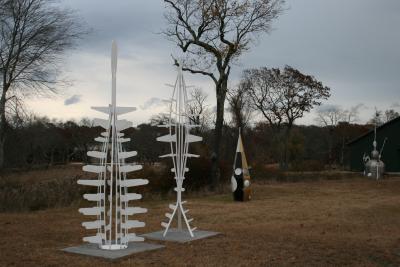A Hamptons Williamsburg?

After nearly 20 years in Springs, Dana Dolan, an artist, moved to Miami Beach three years ago. When the glitz of her condo on Collins Avenue failed to move her, she sought the desert life in Santa Fe, N.M. But when she awoke one night to find a five-inch centipede in bed with her, she decided to return to the South Fork.
Alas, prices had gone up and Springs was “unaffordable.” So she did what increasing numbers of the financially challenged are doing: bought a house in Flanders.
Flanders?
Located in the Town of Southampton, it is decidedly the most unHamptony Hampton imaginable — the place most of us know as the place we have to pass through on our way to Riverhead. And, of course, it’s the home of the Big Duck. Indeed, the 11-square-mile hamlet was once predominately duck farms.
But before that, in the hamlet’s heyday starting in the 1870s, it was home to nearly a dozen tony summer hotels and boarding houses. According to its historical society, the “very exclusive Flanders Club, a sportsmen’s club,” with a membership of “wealthy N.Y.C. businessmen,” was built there in 1891 and would “eventually control 10,000 acres of marsh and upland. . . .”
These days Flanders is mostly a warren of tiny lots dotted with Monopoly houses, the Jersey Shore in the Hamptons’ backyard. Yet, with it not unusual for a property to go for less than $200 grand, it is attracting first-time homebuyers and others from more expensive areas farther east. Could it be the Williamsburg of the Hamptons?
Ms. Dolan’s house, a roughly 900-square-foot ranch with a fireplace and deck on slightly under a quarter acre, sold in the low 200s. Did we mention that it commands water views? It’s not directly on the water, but there’s a vista over marshland. The northern perimeter of Flanders is jagged coastline, bordering on various bodies of water that empty into Great Peconic Bay. Waterfront views abound. However, there’s a catch: Much of the coastline was heavily battered during Hurricane Sandy. Ms. Dolan cannot get flood insurance.
“I have had people gun-shy because of Sandy,” said Sherry Patterson, a broker at Tuccio Real Estate in Riverhead. “There was damage, but people are coming back and rebuilding.” This time, she said, many houses are going up on stilts. “There are a lot of good deals now because a lot of people want out” because of Sandy. Flanders “has always been an untapped spot, part is the name, the connotation . . . but there’s woodland, parkland, waterfront.”
Ms. Dolan’s house sold in the mid-400s during the boom, then went into foreclosure during the downturn. A savvy buyer purchased it, jazzed it up with new appliances, and flipped it. “When the market went south there were a glut of foreclosures,” said Ms. Patterson. But they’ve been “cleaned up . . . when the market was doing well Flanders was booming with everyone else . . . it’s still in the process of recovering.”
Probably the first pioneer in the current wave of Flanders gentrification was Gloria Kisch, a well-known sculptor who had a solo show at Guild Hall in 2010. Fourteen years ago Ms. Kisch, who owned a house in Bridgehampton, was looking for a place to fabricate her work and required a great deal of space. She found a 40-acre former duck farm in Flanders. “Everyone thought I was crazy,” she said.
She designed and built a modern house filled with many of her sculptures, including a stainless staircase railing, that looks out over a private pond (one of three) surrounded by high reeds. Dozens of her sculptures dot the rolling hills of her landscape, which overlooks another 82 acres of wildlife preserve.
“When I moved here it was a dangerous place to live.” She admits to having been “terrified.” But now, with her career achieving new heights, “I give this place all the credit.” Ms. Kisch paid a song for the property, less than a tiny house in Springs would cost today.
Near Ms. Kisch is a road called Pleasure Drive. “I can’t tell you what a dump it was 14 years ago,” she said, pointing out that front yards were filled with “old cars and refrigerators.” Now the road boasts large lots with houses on a couple of acres valued in the 400s. There’s even a horse farm on the road.
Dhonna Goodale, an actress and producer who grew up in the city but spent summers in Flanders as a child, has lived for many years with her family on Iron Point, a cape that juts into Flanders Bay, a finger of Great Peconic Bay. “Flanders has always been the stepchild of the Hamptons,” she said. “But we’re starting to see something . . . there’s money coming back in.”
There is one aspect of Flanders real estate that isn’t a deal. Taxes. With a low population — 4,472, according to the 2010 census — the hamlet is part of the Riverhead School District. So homeowners pay taxes to both Southampton and Riverhead Towns. The taxes in Flanders are “higher than other places in Southampton,” Ms. Patterson said.
Meanwhile, Ms. Dolan and Ms. Kisch are more than happy with the location, a less-than-five-minute drive for each of them into downtown Riverhead with its growing number of trendy restaurants. Then there are the area’s big-box discount stores. The big excitement: A Costco is being built nearby. And the local Stop & Shop gives points for gas.
Speaking of gas, prices there can be 50 cents less than prices out east. The city is 90 minutes away. And the Hamptons are close too, but who needs ’em?
